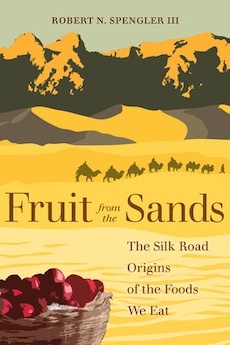By Fred H. Lawson
Movement across the vast heartland of the Eurasian landmass is most often envisaged in terms of either the expansion and contraction of nomadic empires or the trade in such luxury goods as silk, spices, and tea. Yet alongside these epic flows of high politics and conspicuous consumption have run constant currents consisting of more quotidian items: millet, rice, barley, beans, apples, walnuts, and spinach—to list just a few. Robert Spengler offers a compendium of non-animal foodstuffs that have traversed the highways linking the far-flung oases of Inner Asia over the past four thousand years. The book distills information contained in an impressive range of sources: Chinese, Indian, and Arab chronicles; European and Asian travelers’ accounts; Soviet-era archaeological treatises; and modern scientific journals—among many others.
Readers can safely dismiss as poetic license the author’s exaggerated introductory claim that the book will “track a selection of plants on their historical journey along the trans-Eurasian exchange routes, revealing how the food on your kitchen table made its way across deserts, over mountains, and through thousands of farming seasons, and how the introduction of new crops changed the course of human history.” A much larger volume would be required to accomplish that immense project. Nevertheless, any study that proposes to trace the spatial diffusion of a number of agricultural products might be expected to chart the progress of different kinds of rice, chickpeas, pistachios, or whatever in a systematic fashion. Where did the crop in question originate? Approximately when did it show up somewhere else? What route did it take to get there? Spengler devotes little if any attention to such basic questions, and no doubt for good reason: The state of current archaeobotanical research makes it impossible to determine the answers with any degree of certainty.
What remains are snapshots of an assortment of agricultural produce that in one way or another, and at some time or other, ended up making contact with the Silk Road. For example, “the only evidence thus far for durum-type wheat in Central Asia,” Spengler observes, “comes from Tashbulak, the high-elevation medieval town in Uzbekistan. While working at the site,” he continues, “I recovered a few wheat rachises from Tashbulak that express the clear morphology of a free-threshing tetraploid.” Similarly, “the discovery of seventh- and eighth-century apricot pits, along with a variety of other fruit remains, in the fortified site of Mugh in northern Tajikistan suggests that they were a prominent part of the landscape in the past there as well.” Intriguing tidbits like these pepper the text, whetting the reader’s appetite for sustained explorations of each tasty morsel.
Fred H. Lawson (ΦBK, Indiana University) is professor of government emeritus of Mills College.




